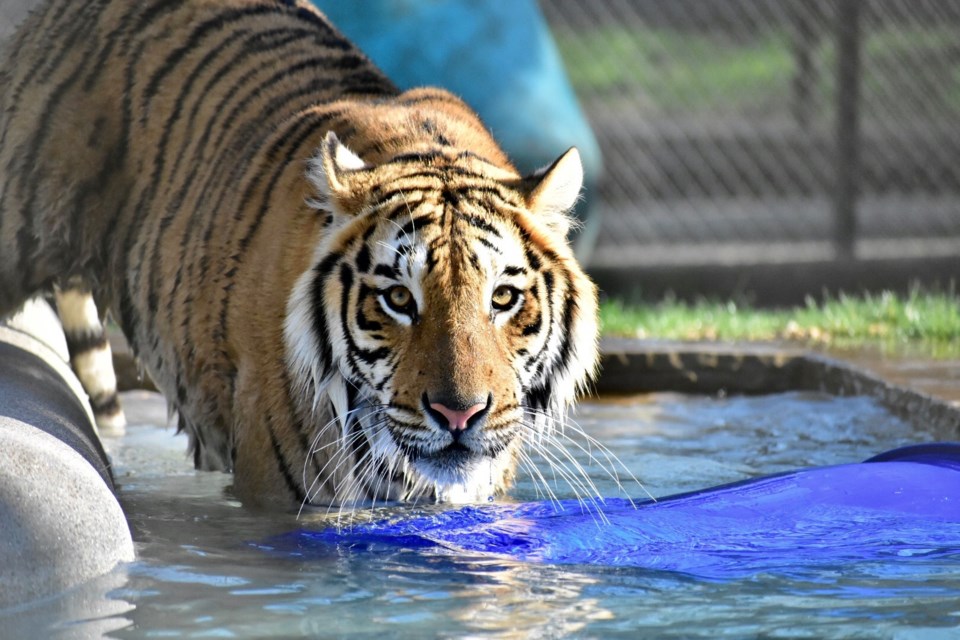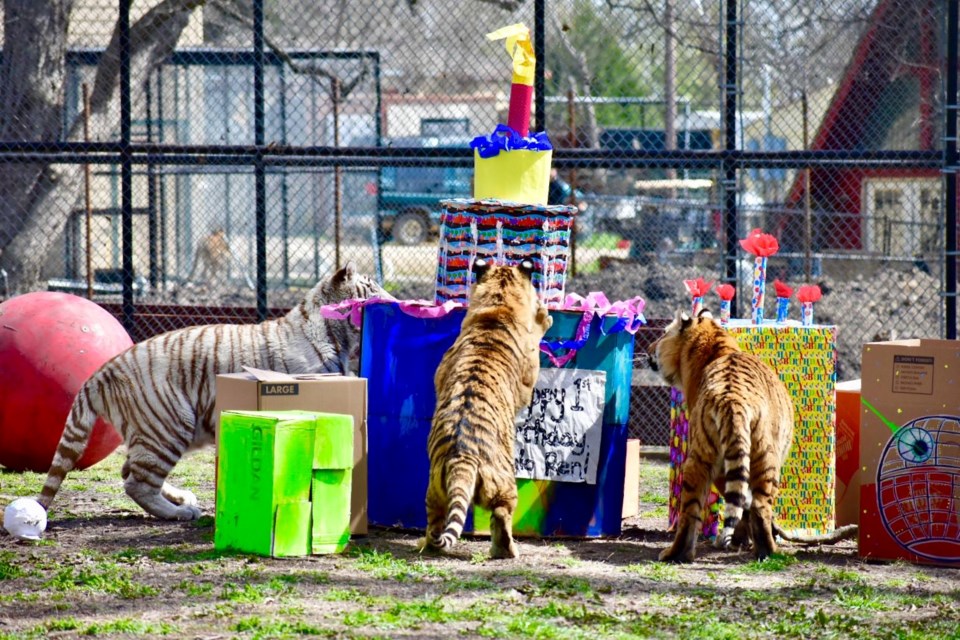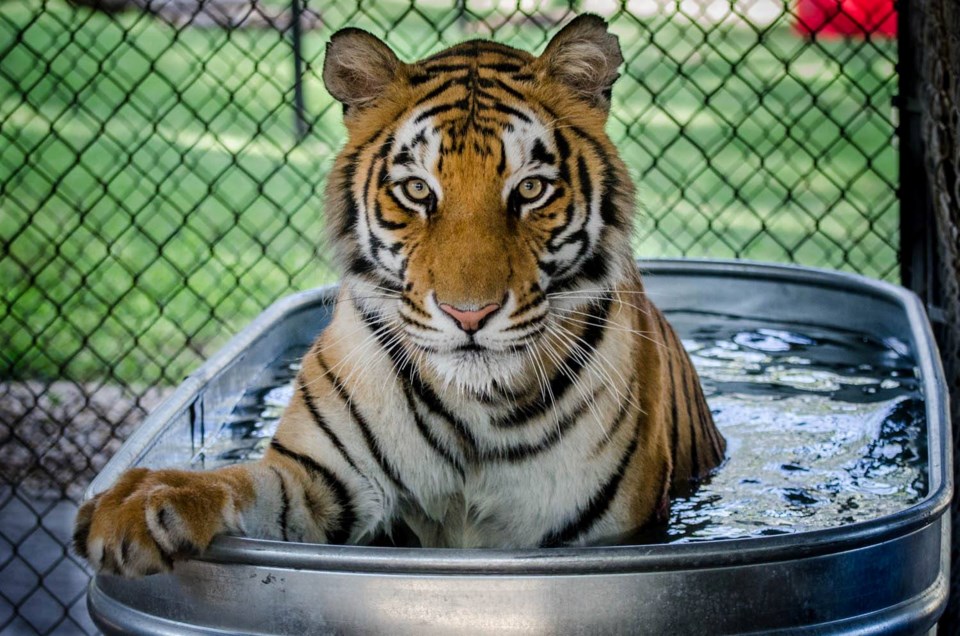
When “Tiger King: Murder, Mayhem and Madness” aired, the staff at InSync Exotics, an exotic animal sanctuary established in Collin County in 2000, didn’t know what to think. The smash hit docuseries centers on Oklahoma zookeeper Joe Exotic, the culture of exotic animal ownership, and the feud that culminated in an alleged murder-for-hire plot against animal rights activist Carole Baskin.
The InSync Exotic staff run in the same circles as the docuseries. They had all seen the videos of Joe Exotic—real name Joseph Maldonado-Passage—shooting a mannequin and calling it Carole. They’d seen Joe Exotic’s presidential campaign and the music videos and known about the ensuing court case and attempted murder for hire. They had certainly noticed the man who, across the Texas-Oklahoma border, housed one of the largest big cat collections in the world at the GW Zoo. The viral docuseries was exposing their world too, and it was hard not to remember that they did the same work Carole Baskin did, and it could have gotten them killed.
“For my blood pressure I can only watch so much,” says Angela Culver, a spokesperson for InSync Exotics.
For Culver and the rest of the staff, the controversy is not new in the world of big cats. They’ve never had direct dealings with Joe Exotic, but they have been concerned about the existence of GW Zoo and other places that allow cub petting. They followed his arrest and trial with the same disbelief and resigned fascination the rest of us felt watching it on Netflix.
The difference is, according to Culver, they’ve known about him for a long time.
Culver knows of Carole Baskin too, but only by reputation as an advocate for ending private ownership and breeding of big cats. Many of what she calls the “true big cat sanctuaries” are in contact with each other. As for what’s true and what isn’t—and who, exactly, was guilty of what—she isn’t so sure.
“These are really passionate and eccentric people,” she says. “And a bit rash.”
Tiger King has swept the nation into a Joe Exotic fervor. Many people feel that Joe Exotic received too harsh a punishment for his crimes. Others have become warriors against cub-petting and breeding. Miranda Lambert posted a photo of herself with Joe Exotic and other key players taken at a MuttNation Foundation event in 2017, then had to defend herself and assert that she “obviously” didn’t condone animal abuse. In a briefing last Wednesday, President Trump said that he would “take a look” at the case and think about pardoning him — though he has not seen the series yet.
He seems to be in the minority of viewers. The docuseries racked up 34.3 million unique viewers in the U.S. within its first 10 days of being released, according to Nielsen estimates. It was popular enough that they released an “aftershow,” “The Tiger King and I,” to further address it.
The exotic animal world has never had a bigger spotlight or microscope.
The first matter Culver clarifies is that InSync Exotics does not condone any place that does hands-on interaction between the public and cats or any organization that breeds them like Joe Exotic.
For a real sanctuary, the documentary is both frustrating to watch, but also—incredibly valuable as a way to bring the issues of conservation and ownership of exotic animals to the forefront.
“You know, people think cub petting is such a cool opportunity to interact with a tiger,” Culver says. “You get a picture, and the money goes to conservation efforts! They don’t know any better.”
As she explains, the problem with breeding in captivity is that it does nothing for the actual problem of endangered wild tigers and simply opens the door for abuse and neglect of the animals. “They say they’re helping numbers in the wild, but they’re just breeding these cats for money-making,” Culver says. “It’s not a conservation effort whatsoever.”
The docuseries left viewers with the sense that in the big cat world, there was a culture of two sides: private owners and sanctuaries.
“Absolutely,” Culver confirms.
She describes a true divide that boils down to a question of focus. In one camp, the focus is ego-centric: “I’m an American, I have freedom, I can own these exotic animals.” For sanctuaries, she says, the focus is on the kind of life that animal is leading. “They didn’t ask to be born into captivity. They didn’t ask for it to happen.”
Conservation is also much more complicated than simply breeding more big cats. True conservation deals with intricate issues of habitat loss, poaching, and food sources. Even so, the tigers bred in captivity by private owners aren’t bred with species in mind, leading to what Culver calls “generic” results.
The actual world of big cats is much more complex. For example, nine different subspecies of tigers are found all over the world; three are extinct. Siberian tigers, also known as Amur tigers, are the largest; males can weigh over 600 pounds. Bengal tigers are found primarily in Southeast Asia and are the most common in the world. South China tigers are one of the 10 most endangered animals in the world; only 20 remain in the wild.
However, private breeders typically don’t breed by subspecies. The thousands of tigers bred in captivity don’t have accurate DNA records. Culver describes a much more lax attitude toward breeding. “This one has characteristics like a Siberian, so say it’s Siberian—let’s just say it’s a Siberian,” she says. “They say they’re working for conservation, but that’s misguided at best.
Sadly, even if they could be released in the wild, there is simply not enough habitat left to support the number of cats living in captivity. They vastly outnumber the cats left in the wild.
Big cats come to InSync Exotics in a variety of ways. Sometimes private owners regret their purchase and contact the sanctuary themselves. Others are from USDA seizures or seizures from various other government branches.

A couple of years ago, a story broke about a tiger cub discovered as he was being smuggled across the border in a duffel bag, destined for the highest bidder. Now that tiger is at InSync Exotic. His name is Kenobi. He has two best friends, male tigers of the same age that the sanctuary calls the Jedi Boys, and every day, they play in their playground, which is about 10,000 square feet.
“He is doing great,” Culver says. “He loves playing in the pool, splashing with Kylo Ren and Anakin, playing or napping. All three were rescued.” Kylo Ren was born at sanctuary; his mother had been rescued while pregnant. Anakin came from a facility that couldn’t care for him anymore.
The reaction to Joe Exotic and Carole Baskin has been widespread and delighted. It was a surprise hit in the middle of the COVID-19 pandemic, distracting us exactly when we needed it. Culver hopes the message at the end wasn’t missed in the drama: that there are sanctuaries all around the country that only exist to rescue these animals from breeding conditions and private ownership. Culver says that this kind of exposure being given to the animal conservation effort and big cat breeding is unprecedented.
“In the end,” she says, “We don’t want to exist. Every year there are more cats that need a place to go like ours. There are already more exotic animals than we can house.”



![Another Puppy Stolen From Petland Frisco [Update]](https://www.vmcdn.ca/f/files/localprofile/images/news/petland.jpeg;w=120;h=80;mode=crop)
